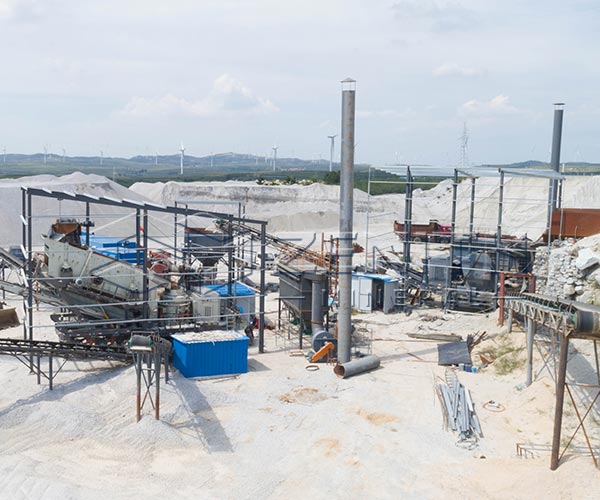Comprehensive Overview of Silica Sand Processing Plant and Its Core Functions
A silica sand processing plant is an industrial facility dedicated to transforming raw silica-containing materials into purified silica sand with specific particle sizes and minimal impurities. The core functions include:
- Extraction and initial handling: Raw silica sand is mined or extracted from deposits and transported to the processing plant.
- Crushing: Large silica rocks or ores are reduced in size to facilitate further processing.
- Washing and scrubbing: Removal of clay, silt, and organic impurities to improve sand purity.
- Screening and classification: Separation of sand particles into uniform size ranges for specific applications.
- Separation and purification: Use of gravity, magnetic, and chemical methods to remove iron and other contaminants.
- Dewatering and drying: Reduction of moisture content to prepare the sand for storage or shipment.
This multi-step process ensures that the final product meets industrial standards for purity and grain size.
Detailed Explanation of Crushing Equipment and Its Role in Size Reduction
The crushing stage is the first and one of the most critical steps in silica sand processing. It involves breaking down large raw silica materials into smaller, manageable sizes suitable for washing and screening.
Jaw Crushers:
Used for primary crushing, jaw crushers apply compressive force to break large rocks into pieces typically ranging from 100 to 200 millimeters. The moving jaw compresses the material against a fixed jaw plate, effectively reducing the size of the raw silica stones.
Cone Crushers:
Employed for secondary and fine crushing, cone crushers use a combination of compression and shear forces. The eccentric rotation of the mantle inside the bowl liner crushes the material further, producing a more uniform particle size between 10 to 50 millimeters.
These crushers prepare the silica sand for subsequent washing and screening processes by ensuring appropriate particle size distribution.
In-Depth Description of Washing and Scrubbing Processes for Impurity Removal
Washing and scrubbing are essential to remove impurities such as clay, silt, and organic matter that adhere to silica sand particles. The process typically involves:
- Feed Hopper: Raw silica sand is fed into the washing system through a hopper that regulates the flow.
- Attrition Scrubbers and Log Washers: These machines agitate the sand with water to scrub off clay and other sticky impurities.
- Spiral Sand Washers: These remove fine mud and clay by spiraling the sand upwards while washing it with water.
- Hydrocyclones: Used to classify sand particles by size and density, hydrocyclones separate finer particles and help in dewatering.
The washing stage is crucial for improving the purity and quality of silica sand, making it suitable for high-end applications like glass manufacturing.
Exhaustive Insights into Screening and Classification for Particle Size Uniformity
Screening and classification ensure that silica sand particles are sorted into specific size ranges, which is vital for meeting customer specifications and industry standards.
- Trommel Screens: Rotary screens with specific mesh sizes separate particles larger or smaller than the desired size (e.g., 2 mm).
- Vibrating Screens: These further classify the sand by size, ensuring uniformity.
- Hydraulic Classification Drums: Used to remove ultra-fine particles less than 0.1 mm, improving the sand’s quality.
The screening process often involves multiple stages, with oversize particles being sent back for re-crushing or grinding, and undersize particles proceeding to washing or drying.
Comprehensive Overview of Separation and Purification Techniques to Enhance Silica Sand Quality
After washing and screening, silica sand undergoes separation processes to remove heavy minerals and iron impurities:
- Spiral Chutes: These gravity separation devices separate heavier minerals like iron from lighter silica sand.
- Magnetic Separators: Plate magnetic separators use strong magnets to attract and remove iron-containing minerals, reducing iron content to less than 0.02%.
- Flotation Cells: Sometimes used to separate mica, feldspar, and other impurities by attaching them to air bubbles for removal.
These purification steps are critical for producing high-purity silica sand suitable for sensitive industrial uses.
Essential Role of Dewatering and Drying Systems in Final Product Preparation
After washing and separation, silica sand contains significant moisture, which must be reduced before storage or transportation:
- Dewatering Screens: Remove excess water from the sand slurry.
- Hydrocyclones and Slurry Pumps: Aid in fine sand recovery and water recycling.
- Dryers: Final drying equipment reduces moisture to acceptable levels for the finished product.
Efficient dewatering and drying not only improve product quality but also reduce transportation costs and prevent product degradation.
Summary of Equipment and Flowchart Integration in a Typical Silica Sand Processing Plant
A typical silica sand processing plant integrates various equipment in a streamlined flow:
- Feeding: Raw sand is fed via vibrating feeders.
- Crushing: Jaw and cone crushers reduce particle size.
- Screening: Trommel and vibrating screens classify particles.
- Washing: Spiral washers and scrubbers remove impurities.
- Separation: Spiral chutes and magnetic separators purify sand.
- Dewatering: Screens and hydrocyclones remove moisture.
- Stockpiling: Finished sand is conveyed to storage.
This flow ensures efficient processing and high-quality output tailored to customer needs.
Silica sand processing plants are complex systems that combine mechanical and chemical processes to produce purified silica sand. Crushing reduces raw material size, washing removes impurities, and screening ensures particle uniformity. Separation techniques further enhance purity, while dewatering and drying prepare the sand for final use. Each stage is vital to meet the demanding specifications of industries relying on high-quality silica sand.

